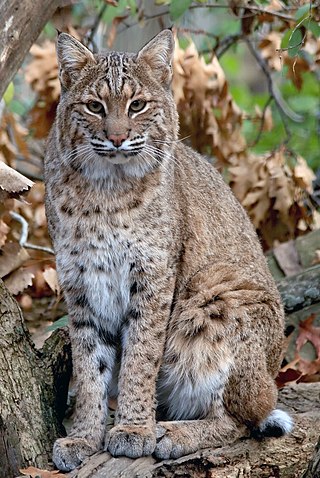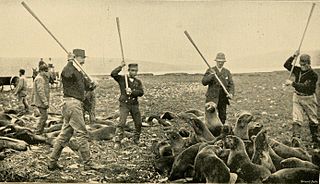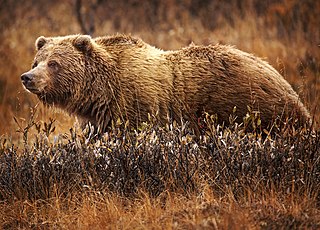
The moose or elk is the only species in the genus Alces. It is the largest and heaviest extant species of deer. Most adult male moose have distinctive broad, palmate antlers; most other members of the deer family have antlers with a dendritic ("twig-like") configuration. Moose typically inhabit boreal forests and temperate broadleaf and mixed forests of the Northern Hemisphere in temperate to subarctic climates. Hunting and other human activities have caused a reduction in the size of the moose's range over time. It has been reintroduced to some of its former habitats. Currently, most moose occur in Canada, Alaska, New England, New York State, Fennoscandia, the Baltic states, Poland, Kazakhstan, and Russia.

The wolf, also known as the gray wolf or grey wolf, is a large canine native to Eurasia and North America. More than thirty subspecies of Canis lupus have been recognized, including the dog and dingo, though gray wolves, as popularly understood, only comprise naturally-occurring wild subspecies. The wolf is the largest extant member of the family Canidae, and is further distinguished from other Canis species by its less pointed ears and muzzle, as well as a shorter torso and a longer tail. The wolf is nonetheless related closely enough to smaller Canis species, such as the coyote and the golden jackal, to produce fertile hybrids with them. The wolf's fur is usually mottled white, brown, gray, and black, although subspecies in the arctic region may be nearly all white.

The walrus is a large pinniped marine mammal with discontinuous distribution about the North Pole in the Arctic Ocean and subarctic seas of the Northern Hemisphere. It is the only extant species in the family Odobenidae and genus Odobenus. This species is subdivided into two subspecies: the Atlantic walrus, which lives in the Atlantic Ocean, and the Pacific walrus, which lives in the Pacific Ocean.

Hunting is the human practice of seeking, pursuing, capturing, or killing wildlife or feral animals. The most common reasons for humans to hunt are to exploit the animal's body for meat and useful animal products, for recreation/taxidermy, although it may also be done for non-exploitative reasons such as removing predators dangerous to humans or domestic animals, to eliminate pests and nuisance animals that damage crops/livestock/poultry or spread diseases, for trade/tourism, or for ecological conservation against overpopulation and invasive species.

The American black bear, also known as the black bear, is a species of medium-sized bear endemic to North America. It is the continent's smallest and most widely distributed bear species. The American black bear is an omnivore, with its diet varying greatly depending on season and location. It typically lives in largely forested areas, but will leave forests in search of food, and is sometimes attracted to human communities due to the immediate availability of food.

Fox hunting is a traditional activity involving the tracking, chase and, if caught, the killing of a fox, normally a red fox, by trained foxhounds or other scent hounds. A group of unarmed followers, led by a "master of foxhounds", follow the hounds on foot or on horseback.

The bobcat, also known as the red lynx, is a medium-sized cat native to North America. It ranges from southern Canada through most of the contiguous United States to Oaxaca in Mexico. It is listed as Least Concern on the IUCN Red List since 2002, due to its wide distribution and large population. Although it has been hunted extensively both for sport and fur, populations have proven stable, though declining in some areas.

Game or quarry is any wild animal hunted for animal products, for recreation ("sporting"), or for trophies. The species of animals hunted as game varies in different parts of the world and by different local jurisdictions, though most are terrestrial mammals and birds. Fish caught non-commercially are also referred to as game fish.
Chris Hodgson is a former politician in Ontario, Canada. He was Reeve of Dysart country in 1993, and warden of Haliburton. He was a Progressive Conservative member of the Legislative Assembly of Ontario from 1994 to 2003 representing the ridings of Victoria—Haliburton and Haliburton—Victoria—Brock. He was a cabinet minister in the governments of Mike Harris and Ernie Eves, serving variously as Minister of Northern Development and Mines, Chair of the Management Board of Cabinet and Deputy Government House Leader, and Minister of Municipal Affairs and Housing.
A canned hunt is a trophy hunt which is not "fair chase", typically by having game animals kept in a confined area such as in a fenced ranch to prevent the animals' escape and make tracking easier for the hunter, in order to increase the likelihood of the hunter obtaining a kill. The term has been used for driven grouse shooting, in which large areas of Britain are farmed for red grouse. According to WordNet, a canned hunt is a "hunt for animals that have been raised on game ranches until they are mature enough to be killed for trophy collections."

Sheila Watt-Cloutier is a Canadian Inuk activist. She has been a political representative for Inuit at the regional, national and international levels, most recently as International Chair for the Inuit Circumpolar Council. Watt-Cloutier has worked on a range of social and environmental issues affecting Inuit, most recently, persistent organic pollutants and global warming. She has received numerous awards and honours for her work, and has been featured in a number of documentaries and profiled by journalists from all media. Watt-Cloutier sits as an adviser to Canada's Ecofiscal Commission. She is also a senior fellow at the Centre for International Governance Innovation.

Seal hunting, or sealing, is the personal or commercial hunting of seals. Seal hunting is currently practiced in nine countries: United States, Canada, Namibia, Denmark, Iceland, Norway, Russia, Finland and Sweden. Most of the world's seal hunting takes place in Canada and Greenland.

Wolf hunting is the practice of hunting wolves. Wolves are mainly hunted for sport, for their skins, to protect livestock and, in some rare cases, to protect humans. Wolves have been actively hunted since 8,000 to 10,000 years ago, when they first began to pose a threat to livestock of Neolithic human communities. Historically, the hunting of wolves was a huge capital- and manpower-intensive operation. The threat wolves posed to both livestock and people was considered significant enough to warrant the conscription of whole villages under threat of punishment, despite the disruption of economic activities and reduced taxes. The hunting of gray wolves, while originally actively endorsed in many countries, has become a controversial issue across the globe. Most people see it as cruel, unnecessary and based on misconceptions, while proponents argue that it is vital for the conservation of game herds and as pest control.
Ontario OUT of DOORS (OOD) is a Canadian magazine focusing on recreational hunting, fishing and the outdoors in the province of Ontario. OOD is published 10 times per year and is owned by the Ontario Federation of Anglers and Hunters (OFAH).

Safari Club International (SCI) is a US organization composed of hunters dedicated to protecting the freedom to hunt. SCI has more than 50,000 members and 180 local chapters. SCI members agree to abide by the organization's code of ethics, which includes making a positive contribution to wildlife and ecosystems, complying with game laws, and assisting game and fish officers.

Apitipi Anicinapek Nation, formerly known as Wahgoshig First Nation, is an Algonquin Anicinape community, located near Matheson in Cochrane District in northeastern Ontario, Canada. In January 2008, the First Nation had 270 people registered with the nation, of which their on-reserve population was 121.

Bear hunting is the act of hunting bears. Bear have been hunted since prehistoric times for their meat and fur. In addition to being a source of food, in modern times they have been favored by big game hunters due to their size and ferocity. Bear hunting has a vast history throughout Europe and North America, and hunting practices have varied based on location and type of bear.
Manitoulin Streams Improvement Association is a not for profit group that rehabilitates streams, rivers and creeks on the largest lake island in the world Manitoulin Island, Ontario, Canada. They partner with the entire community, including farmers, fisherman, and local lake and fish associations. Their rehabilitation projects enhance water quality and the fisheries resource on Manitoulin Island and Lake Huron which is fed by the streams. These streams were once very productive for salmon and trout spawning, but have been destroyed by centuries of human land use practices.

The grizzly bear, also known as the North American brown bear or simply grizzly, is a population or subspecies of the brown bear inhabiting North America.

Polar bear population sizes and trends are difficult to estimate accurately because they occupy remote home ranges and exist at low population densities. Polar bear fieldwork can also be hazardous to researchers. As of 2015, the International Union for Conservation of Nature (IUCN) reports that the global population of polar bears is 22,000 to 31,000, and the current population trend is unknown. Nevertheless, polar bears are listed as "Vulnerable" under criterion A3c, which indicates an expected population decrease of ≥30% over the next three generations due to "decline in area of occupancy, extent of occurrence and/or quality of habitat". Risks to the polar bear include climate change, pollution in the form of toxic contaminants, conflicts with shipping, oil and gas exploration and development, and human-bear interactions including harvesting and possible stresses from recreational polar-bear watching.